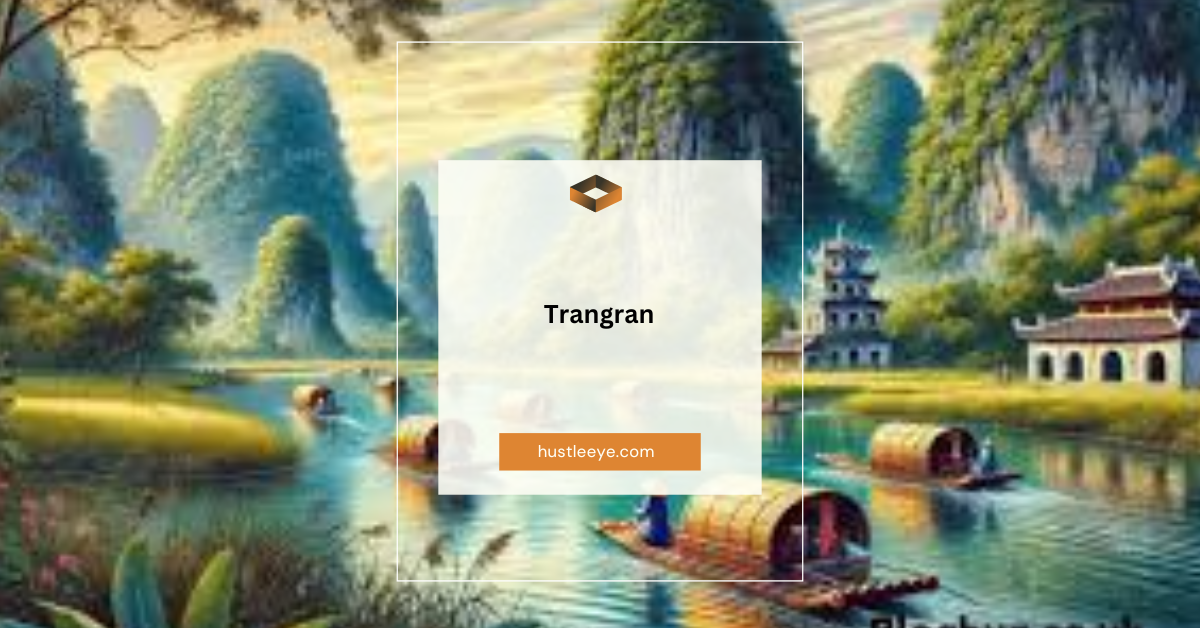Trangran is a mesmerizing art form that goes beyond being a mere craft. It is an intricate fusion of history, culture, and creativity that has stood the test of time. With roots in Southeast Asia, Trangran captures the essence of cultural storytelling through complex patterns, vibrant colors, and unique techniques passed down through generations. In this article, we will explore the fascinating world of Trangran, its origins, cultural significance, evolution, and modern revival.
This comprehensive guide is designed for a basic English-speaking audience in the USA, offering insights into how Trangran has evolved and how its modern interpretations continue to captivate new generations. Whether you’re an art enthusiast or just curious about different cultural traditions, this journey into Trangran will enrich your understanding of a truly unique art form.
Table of Contents
What is Trangran?
Trangran is a traditional art form originating from Southeast Asia, known for its intricate designs and cultural depth. It involves a variety of artistic techniques, often seen in pottery, woodwork, and mural painting, that reflect the rich histories and traditions of the regions where it was developed. What makes Trangran special is its ability to tell stories through the use of patterns and symbols, giving each piece a deep meaning that connects the past with the present.
In modern times, Trangran has seen a resurgence as artists blend traditional elements with contemporary styles. This has sparked a renewed interest in Trangran, especially among younger generations who are eager to preserve and reinterpret their cultural heritage.
Origin and Development of Trangran:
The origin of Trangran can be traced back several centuries to ancient Southeast Asian civilizations. Initially, Trangran was a functional art form used in everyday objects such as pots, tools, and fabrics. Over time, these objects began to take on more aesthetic qualities, and Trangran developed into a recognized art form celebrated for its complexity and beauty.
Early Use and Functional Beginnings:
Trangran was born out of necessity, with early artisans creating tools and objects adorned with simple designs to serve practical purposes. These early works were typically made from natural materials such as clay, wood, and bamboo, readily available in their surroundings.
Cultural Influence and Evolution:
As trade routes expanded and cultural exchanges took place, Trangran evolved. Artists began incorporating influences from neighboring countries, adding new techniques and styles. For example, Chinese ceramics and Indian textiles played a role in shaping Trangran’s visual language. This fusion created a diverse and adaptable art form that has managed to survive and thrive throughout the centuries.
Globalization and the Revival of Traditional Art:
In recent decades, the trend of globalization has reignited interest in traditional arts like Trangran. Younger generations in Southeast Asia, as well as art lovers from around the world, have become increasingly fascinated by the depth and history of this art form. Trangran has thus experienced a modern revival, with artists breathing new life into age-old techniques.
Cultural Significance of Trangran:
Trangran is more than just art—it’s a way of preserving cultural identity. Each design tells a story that reflects the values, beliefs, and history of the community in which it was created. This makes Trangran a vital link to the past, allowing modern generations to connect with their ancestors in a tangible way.
1. A Medium for Storytelling:
In many ways, Trangran serves as a visual language. Each pattern and symbol represents a story, whether it be a tale of love, loss, triumph, or spirituality. These stories are passed down from generation to generation, often used to teach lessons or celebrate important events.
For example, certain designs in Trangran pottery may symbolize fertility and growth, while others may represent the strength and resilience of a community. The stories told through Trangran are deeply personal, yet universally relatable.
2. Preserving Tradition in a Modern World:
As the world becomes increasingly modernized, many traditional practices risk being lost. However, Trangran has managed to remain relevant by adapting to the changing world. Artists today incorporate both traditional and contemporary elements into their work, ensuring that the legacy of Trangran continues.
Festivals and community events often showcase Trangran art, reinforcing its significance and encouraging younger generations to engage with their cultural heritage.
Techniques and Materials Used in Trangran Art:
Trangran is known for its unique techniques and the use of natural materials. Artists often employ a combination of traditional methods passed down through generations, along with more modern innovations to push the boundaries of the art form.
1. Traditional Techniques:
The foundation of Trangran lies in its meticulous craftsmanship. One of the primary techniques involves layering materials to create depth and texture in each piece. These layers often tell a story, with each one representing a different element of the overall narrative.
Hand-carving is another essential technique in Trangran, especially in wood and clay works. This requires a high degree of precision and skill, as artisans use handcrafted tools to carve delicate patterns into their materials.
2. Natural Materials:
Trangran is closely tied to nature, and many of the materials used in its creation are eco-friendly. Artists traditionally use materials such as bamboo, wood, and clay, which are abundant and sustainable. These materials are not only practical but also have symbolic meanings. For example, bamboo represents flexibility and strength, while clay signifies the connection to the earth.
Natural pigments derived from plants are commonly used to create the vibrant colors seen in Trangran art. These pigments are mixed with natural binders to ensure that the colors remain vibrant and long-lasting.
Famous Examples of Trangran Artwork:
Several notable works of Trangran art have gained recognition over the years. These pieces exemplify the artistry and cultural significance of Trangran, attracting attention from both historians and contemporary art lovers.
1. The Binh Minh Temple Mural:
One of the most celebrated examples of Trangran art is the mural in the ancient temple of Binh Minh. This intricate piece features vibrant colors and complex patterns that tell stories of local folklore and history. The mural is a testament to the skill and dedication of the artists who created it.
2. The Wood Carvings of Nguyen Lien:
Nguyen Lien, a renowned Trangran artisan, is famous for his wood carvings that depict traditional scenes of daily life. His work captures the essence of Trangran by focusing on the everyday experiences of the people in his community, such as farming, fishing, and family life.
3. The Trangran Pottery Collection:
The Trangran pottery collection at the National Museum is another example of the craftsmanship involved in this art form. Each piece in the collection features intricate designs that are as functional as they are beautiful. These works demonstrate how Trangran art can be integrated into everyday life while still preserving its cultural significance.
Modern Interpretations and Revival of Trangran:
In recent years, Trangran has undergone a revival, with modern artists reinterpreting this ancient art form in new and exciting ways. This contemporary resurgence has led to Trangran being featured in galleries, museums, and online platforms, where it is gaining international recognition.
1. Experimenting with Color and Materials:
Today’s Trangran artists are pushing the boundaries of traditional practices by experimenting with different materials and color palettes. While the original works used natural pigments and materials, modern interpretations may include synthetic colors and even recycled materials, blending environmental consciousness with artistic expression.
2. Trangran in Contemporary Art Exhibitions:
Trangran’s revival is being celebrated in art exhibitions around the world. These exhibitions bring Trangran into the spotlight, introducing this traditional art form to new audiences who may have never encountered it before. This international exposure has not only preserved Trangran but also allowed it to evolve and adapt to modern tastes.
3. Social Media’s Role in Trangran’s Popularity:
Social media platforms such as Instagram and Pinterest have played a crucial role in bringing Trangran to a global audience. Artists now share their work online, reaching people from all corners of the globe. This has sparked collaborations, workshops, and a renewed interest in traditional Southeast Asian art forms, including Trangran.
The Future of Trangran: Preserving Tradition Amidst Change:
As Trangran continues to gain popularity, the challenge lies in preserving the traditional techniques and cultural significance of this art form while allowing it to evolve in response to modern tastes and technologies. The balance between innovation and tradition will be crucial to ensuring that Trangran remains relevant for future generations.
1. Supporting Trangran Artisans:
One of the most important aspects of preserving Trangran is supporting the artisans who keep this tradition alive. Governments, cultural organizations, and individuals can all play a role in ensuring that Trangran artists have the resources and recognition they need to continue their work.
2. Trangran Workshops and Education:
Workshops that teach the art of Trangran are becoming increasingly popular, especially among younger generations eager to reconnect with their cultural roots. These workshops help keep the tradition alive by passing down knowledge from one generation to the next.
FAQs about Trangran:
1. What is Trangran?
Trangran is a traditional art form from Southeast Asia that features intricate designs and patterns, often used in pottery, woodwork, and mural painting. It tells cultural stories and has deep historical significance.
2. What materials are used in Trangran art?
Trangran artists traditionally use natural materials such as bamboo, wood, and clay. Natural pigments derived from plants are also commonly used to create vibrant colors.
3. How has Trangran evolved over time?
Trangran began as a functional art form and evolved into a celebrated cultural practice. It has incorporated influences from neighboring countries and has recently seen a revival as modern artists blend traditional techniques with contemporary styles.
4. Where can I see Trangran art?
Trangran art can be seen in temples, museums, and cultural exhibitions, particularly in Southeast Asia. Some modern Trangran pieces are also featured in international galleries and online platforms.
5. How can I learn Trangran art?
There are workshops available in Southeast Asia and online that teach the techniques and history of Trangran. Many artists also share their work and methods through social media platforms.
Conclusion:
Trangran is more than an art form; it is a cultural legacy that bridges the past and the present. With its intricate designs, rich history, and modern revival, Trangran continues to captivate both traditionalists and contemporary art lovers alike. As this ancient tradition adapts to the modern world, Trangran remains a powerful medium for storytelling, creativity, and cultural preservation. Whether you are a seasoned art enthusiast or a curious newcomer, Trangran offers a unique window into the heart of Southeast Asian culture.
Read More:
- Joinpd.cpm: Your Ultimate Guide to Navigating the Police Department Application Process
- Eaglercraft GitHub: A Comprehensive Guide to Playing Minecraft in Your Browser
- Troubleshooting Zoom Error Code 10004: Comprehensive Guide
- Smartjail: Revolutionizing Prison Communication in the Digital Age
- Topamax Ruined My Life: A Comprehensive Guide to Its Side Effects and Impact


